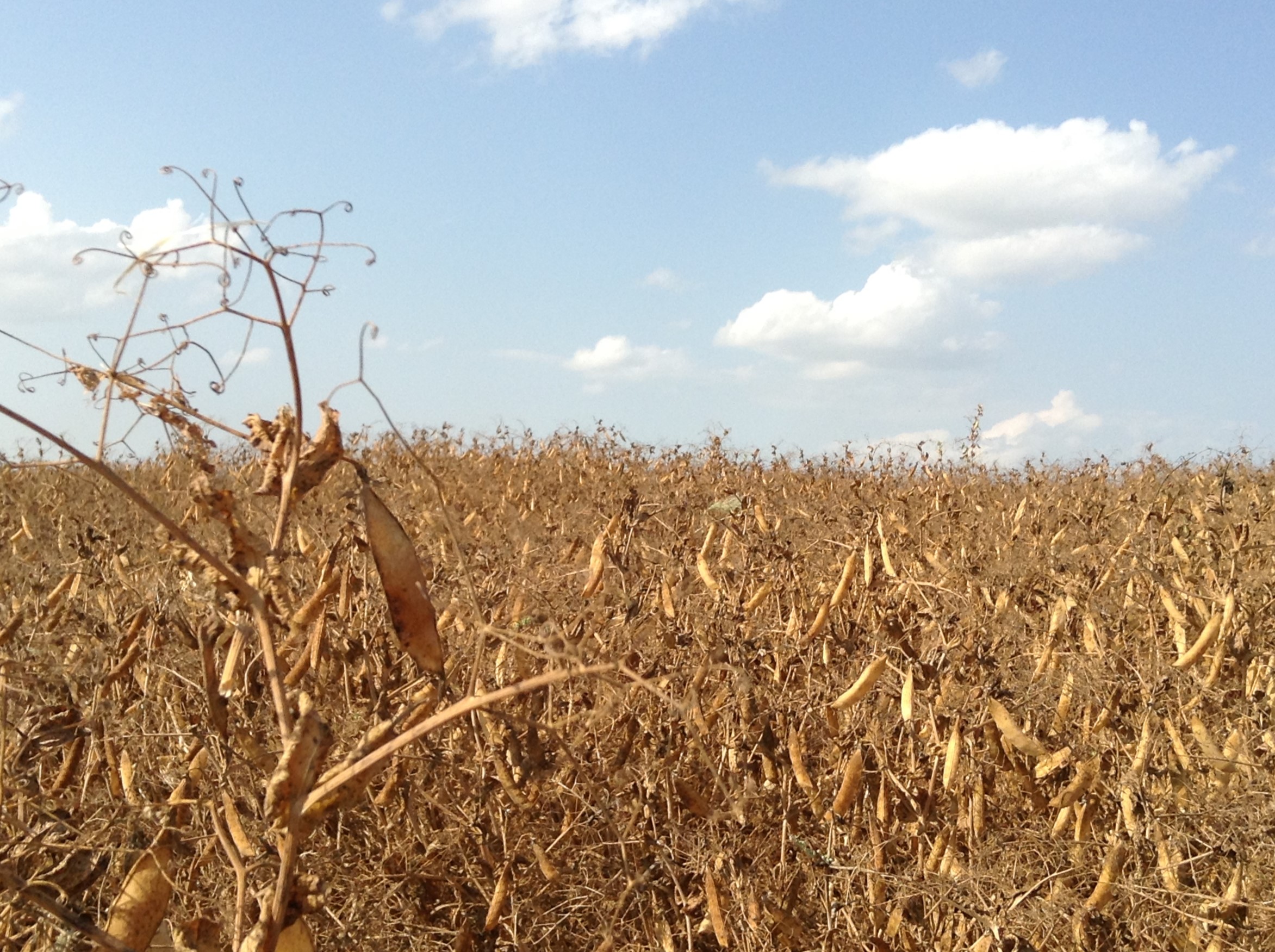“Lower your expectations” – was a comment from a farmer this winter who was asked about how to best harvest field peas. Getting a pea crop off can be slow and challenging, even for experienced growers. But improved genetics, the right equipment options and careful timing can make all the difference.
Dealing with Lodging
Both straight-cutting and windrowing are viable options for harvesting peas, which lodge with increasing severity with wet weather and taller crop canopy height. Varieties of most common market classes (e.g. yellow) are semi-leafless, meaning the leaflets have been replaced by tendrils. These tendrils knit together, improving standability. Newer yellow pea varieties, such as CDC Amarillo, Spectrum, Canary and Athabasca, AAC Ardill and Lacombe and Abarth also have improved lodging resistance over older varieties like Agassiz and CDC Meadow. Use of a foliar fungicide and recommended seeding rates may also decrease lodging.
If direct harvesting, flex headers are typically used to run as close to the ground as possible. Rigid headers can also successfully be used and may be preferred if stones are prevalent in the field. Even if no stones are present, land rolling is a must to reduce earth tag when straight-cutting. Vine lifters and pick up reels aid in harvesting lodged crops by lifting the canopy up over the cutting bar. Vine lifters have been found to reduce harvest losses from 5% to 1.5% of crop yield, decrease plugging and allow for faster harvest speeds (PAMI, 1990). Lifters spaced at 9-12 inches intervals were found to work best.
Swathing can be used if the crop has begun to lodge earlier during the dry down phase. Swathing also facilitates a pick-up header and avoids the risk of picking up stones or earth. Swaths can be quite billowy immediately after swathing and susceptible to wind (pod shatter and movement) so harvest should be timed as quickly as possible after dry down.
Timing Your Operations
Most yellow peas are determinate, but staging maturity of peas for swathing or desiccating can be a bit tricky: the plant flowers and ripens from the bottom up and often, there will be green material at the top of the plant when the majority of the plant is ripening. This means looking across the field from the road could be misleading. Getting into the crop canopy and opening up pods is necessary. After doing some ground truthing, using a drone is a good way of checking the evenness of maturity across the field, especially when you know there are depressions or sandy ridges with contrasting moisture levels that will affect maturity.
Peas are ready to desiccate or swath when the crop reaches R7 – when most pods (75-80%) are yellow/golden brown, seeds in the bottom pods become detached and rattle in the pod and overall seed moisture is <30% (Figure 1).

Harvest can commence in 3-10 days post-desiccant application, depending on the product, heat, moisture conditions and crop stage. Several active ingredients are registered as pre-harvest aids and desiccants for field pea including carfentrazone (Aim, CleanStart), diquat, glyphosate, saflufenacil (Heat LQ/Heat WG) and flumioxazine (Valtera). Some of these actives may restrict export to key markets. Before selecting a product, visit keepingitclean.ca for up-to-date maximum residue limits and consult your grain buyer.
Harvest peas once overall seed moisture is <20% (Figure 2). Combining in the humid parts of the day can reduce shatter loss, but tougher plant material may not feed as well. Matching the pick-up header or reel speed to ground speed will also reduce shatter.

Maintaining Seed Quality
Your harvest operations and weather during harvest can affect seed quality which is important for marketing peas. A few grading factors to keep in mind this harvest are:
- Crack seed coats and splits: These occur when seed is too dry and/or cylinder or rotor speeds are too high. Harvesting at 18-20% seed moisture and slowing cylinder speed with drier grain can reduce seed damage. Run combine and grain cart augers at low speeds and at full capacity.
- Shrivelled seed: Seed appears dimpled and shrunken, due to plant senescence while seed was immature. Carefully timed swathing or desiccation will avoid this issue.
- Bleaching: A grading factor only in green peas, bleaching is caused by excessive moisture (rainfall or humidity) at crop maturity, causing a yellow colour on the cotyledons. Desiccation and prompt harvest can reduce the risk of bleaching.
- Earth tag: A greater issue in peas than in other crops due to the nature of harvest and the texture of the seed coat (which retains dirt). If you are finding earth tag on the seed, check for soil sticking to the flighting on your combine augers. Reduce earth tag by minimizing green or dewy plant material passing through the combine and if necessary, lift the cutting bar.
- Pink peas: Hail can damage pods and allow the bacteria Erwinia Rhapontici to enter and stain peas pink.
- Spoilage: As the peas enter the bin, measure the grain temperature and moisture. If the initial temperature and moisture are within the “no spoilage” zone of Figure 3, grain can be safely stored for up to five months. A general recommendation is to use aeration fans to cool and dry the crop to at least 16% moisture and 15°C.

References
Canadian Grain Commission. 2013. Safe storage guidelines. https://www.grainscanada.gc.ca/storage-entrepose/ssg-de-eng.htm#peas
Prairie Agricultural Machinery Institute and the Alberta Farm Machinery Research Centre. 1990. Pulse Crop Cutting Equipment, Research Report 633.
Schwartz H.F. and M.A.C. Langham. Diagnostic Pocket Series Growth Stages of Pea. ipmPIPE. http://legume.ipmpipe.org/sbr/pea_growth_stages.pdf


